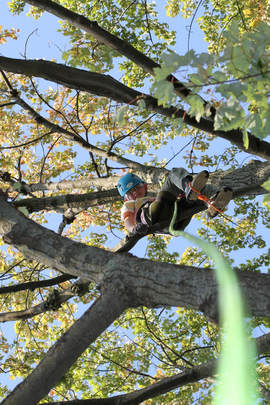 The confidence you have in yourself has a major impact on your level of happiness through life. When I am lacking in confidence as I take on a new task, I find myself immobilized by fear, uncertainty, and feelings of anxiety. My mind says things like, "I can't", "I don't know how", and "I haven't done this before". The view forward is obscured and the task appears overwhelming. Have you experienced this? Have you seen it in your children? Confidence plays an important role in everybody’s life. A person's level of self-confidence is directly related to the level of success they can achieve in pursuit of their life goals. Fortunately, as it is with most skills, we can maintain and build confidence through regular practice. Rock climbing and climbing trees are not only hobbies I enjoy, they provide opportunities for me to build confidence in my abilities. Working through the challenges I face in these hobbies can either build or diminish my level of confidence. Since tree climbing is a hobby I share with others, it provides me the additional perspective of watching others work through their own challenges. In working with many climbers through the years, I have noticed three important steps in building confidence: overcome self-doubt, split a large goal into a series of smaller goals, and focus attention inward. Overcoming Self Doubt "Whether you think you can or think you can't, you are right." Negative self-talk is the first thing that must go. As the case with most challenges, if you are to have any chance at successfully climbing to the top of the tree you will need to overcome self-doubt. This doubt tends to be triggered by fear. Each of us has our own fears to work through. Fear of heights. Fear of embarrassment. Fear of failure. Brand new experiences can be scary. For those facing and working through a fear, self-doubt creates an obstacle. Simply taking the initiative to try something new may be enough to help you overcome your fear. That first step might give you a boost in your confidence. Pair that with a little know-how and you are better able to pursue your goal for the day. My role as a facilitator is to aid you on your journey to reaching your goal. I can show you the technique yet I cannot climb the tree for you. Once you are on rope, my words are all I have to help you. More often than not, they are more than enough if I use them to convey positive thoughts and encouragement. Our fears express themselves in the words we use. This means that the words you use have a profound impact on how well you will perform. "I can't" seems to be the most common and inhibiting phrase I hear people say. These words are typically uttered within one minute of trying to climb; which leads me to believe they are spoken more out of reflex or conditioning. A coach or facilitator can help present a positive environment, but your self-talk often has the biggest impact. In order to move forward, we must stop the negative self-talk. We can replace it with positive words like, "I can do this" and "I am doing it." Speaking and thinking positive words and thoughts instills confidence. Building on a Series of Smaller Goals "What would you attempt to do if you knew you could not fail?" Sometimes our goal is so lofty that we have no idea how to achieve it or even where to begin. In order to reach the goal, we will need to break it down into smaller steps. There are many reasons why this approach leads to success, but I think a primary driver is that it allows us to realize successes at each step. With a small boost in confidence at each step, we are energized and ready to take the next step. With each successive step our confidence continues to grow. When Thomas came to climb with us his first time, his sight was set on climbing to the top of the tree. He came with confidence. As he began to ascend, his focus appeared to be strictly on reaching the top. Focused on that goal, he began to struggle because he tried to skip some of the steps involved in the climbing technique. The sit-stand technique is the foundation of the climbing method. Given his struggle, he naturally resorted to trying alternative methods like pulling with his arms and kicking his legs out. When he realized he was still not getting higher, his frustration began to build and his confidence plummeted. When trying to help a person build confidence, they must be allowed to work on their challenges. Personal growth happens through personal experiences of trial and error. Constantly telling a person how to do something or doing it for them robs them of these invaluable lessons. By having Thomas turn his attention back to the basic steps in the climbing technique, he was able to focus on the fundamentals needed to ascend. The steps necessary to reach his overall goal. With his focus back on using his legs versus his arms, he began to regain some of his confidence. After repeating the process a few times, he realized that he had ascended to 15 feet on his own. In a short period of time, his smaller goal of reaching the first branch was achieved. After a short break to acclimate himself to the height he had climbed (it feels a lot higher when you are looking back down at the ground!), he proceeded to climb higher. Eventually, his ultimate goal was only a few feet away. Thomas' goal of climbing to the top was unachievable until he broke it down into smaller attainable steps. With each success, his confidence grew. With each boost to his confidence, he was prepared to take on the next challenge. Gradually, his ultimate goal came into focus. Do Not Compare Yourself to Others "It doesn't matter what others are doing. It matters what you are doing." Building confidence in yourself has nothing to do with other people. Confidence is understanding and knowing what you are good at or the value you provide. In order to build confidence, you must be focused on yourself and your own experience. When Thomas began to struggle, his frustration was further compounded when he noticed that others were higher than him. He lost confidence when he viewed his slower performance compared to the others as a reflection on his ability to succeed. His ability to climb had absolutely nothing to do with how well the other climbers did. Comparing himself to others only allowed negative self-talk to return and diminish his confidence. Almost like a light switch, when he returned his focus to his own progress, his confidence returned immediately. Hobbies That Build Confidence “The more risks you allow your children to take, the better they learn to look after themselves.” I value activities that challenge and provide me opportunities for growth. Climbing trees for both recreation and work as an arborist has had a tremendous impact on me over the years. These experiences drive my desire to make recreational tree climbing available for others. In doing so, I have seen it have the same impact on those who climb with us each year. From April through October, I am surrounded by people. My weeks are filled with facilitating climbs and teaching classes. One of the most common bits of feedback I receive is in regard to the affect that tree climbing had on the participant's self-confidence; whether it is a parent who has observed it in their child or an adult who has returned to the treetops. The climbing you get to enjoy during our events is not only exciting and fun, it will provide a confidence boost that you can take with you as you pursue new challenges and goals in other areas of your life. With confidence, happiness and success follow. Our Beginning Tree Climbing classes begin in March and public climbs start in April. Until then I encourage you to seek out hobbies and experiences that can help you and your children continue to build confidence until you can return to the trees with us!
2 Comments
Growing up, my brothers and I spent most summer days outside. Even in the heat and humidity of southern Florida, we’d much rather be riding our bikes around the neighborhood, exploring the field behind our house, or hiking to the nearby lake to play along the shore and cool off in the water. We often pitched our tents in the backyard simply because we enjoyed the simplicity and freedom of spending time detached from the television and electronic distractions inside. If it weren’t for my parents’ willingness to let us ‘rough’ it in the back yard and insistence that we get outside and play, I can only wonder where my life’s journey would have brought me to today. When we were younger, we knew that spending time outdoors was the key to a happy life! Benefits of Spending Time Outside Countless studies support this notion, analyzing how crucial outside play is for us and our children. Further, free-play allows us to foster our creativity and decision-making skills. Children, in particular, benefit as they are developing motor planning skills and trying to discover their interests. Studies have shown the benefits of spending time in nature is even greater than simply being outside. If you are one who enjoys hiking, camping, hunting, or canoeing, you are probably already aware of nature’s power to make you relax beyond how you feel when you take a walk around your neighborhood. Reduced stress, improved short-term memory, reduced inflammation, improved concentration, sharper thinking, immune system boosts, and improved mental health are some of the benefits that I have experienced firsthand. I wasn't too surprised when I began looking into and reading studies showing the relationship between children who spend less time in nature and the likelihood they experience attention disorders and depression. I have worked outside for most of my life. I've also had office jobs where I was lucky if I had a window to look out and take in at least the sunshine if not a landscape. Regardless of your age or what your workspace looks like, we cannot escape the fact that we need time in nature; and free-play.  Make Time To Play Outside In the typical progression of life, things seem to get more complicated. As growing adults enjoying our careers, it is quite easy to put in extra hours in pursuit of our goals. At the same time, we may have home repairs, a lawn to mow, meals to make, dishes to clean and so on. If you have kids, this list expands ten-fold, which can make it seem more difficult to send the kids outside for hours on end. Their schedules are filled with structured activities. You may face pressure from people who have different priorities and approaches for their kids. Kids aside, how about your own well-being? I am sure you still find time for fun, entertainment, and getting outside; but, what does your outside time look like these days? Does it primarily consist of yard work, relaxing on the back patio, or at the kids’ soccer game? How much time do you spend in nature? Whatever happened to play time? Do you not have time for either anymore? While I do not play nor spend time in nature nearly as much as I did when I was younger, I know it should be a priority. If the opportunity escapes me for too long, I know it is imperative that I make time as it is as important as proper nutrition. Tree Time I had many favorite climbing trees when I was a kid. In Puerto Rico, there was a magnificent rubber tree (Ficus elastica) at the school playground whose aerial roots and large limbs demanded I swing in the canopy like Tarzan. There was also a rubber tree in our neighbor’s yard in Miami which catered to my dream of living a life like I saw on Swiss Family Robinson. I had a number of favorite climbing trees through the years. Every one of them provided me a place I could go to be alone. I could read a book, challenge my nerve, take a nap or simply lose myself in the serenity of the treetop. 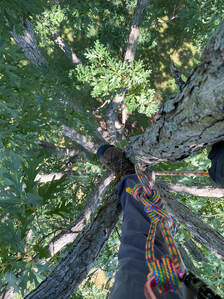 Even today, the benefits I receive from tree climbing often exceed that of other activities primarily because I am outside, breathing fresh air and inhaling the essential oils and compounds emitted by the trees and other components of the natural environment. The further away from concrete & asphalt and the larger the forest ecosystem the tree is growing in, the greater the effect. The climbing process itself heightens your senses and has a profound impact on your brain. You will feel energized once your feet leave the ground, yet you will find peace when you sit back and take in the view. Negative emotions, anxiety and stress will fade away, ushering in positive emotions and a boost in self-confidence and creativity. Feel Better. Be Happy.
As much as I love hiking and playing in my gardens, much of my free-play during the summer is climbing trees for fun. Even though I can get in a personal climb during some of my work days, it is the climbing I do outside of work which impacts me the most. There is no right or wrong way to climb a specific tree, which means you are free to explore as you desire that particular day. One rule: stay tied in on rope at all times…the rest you just make up as you go. Nothing compares to how I feel when I am playing out in the woods, high in a tree. Everything comes into balance. Physically, mentally, emotionally. For me it is climbing trees. For you it may be hiking. Don’t wait for a doctor to prescribe it. Spend a few hours playing in nature this weekend. We were right all along…playing outside is key to a happy life! Are you ready to reconnect with Nature, your inner-child, yourself? Maybe it's time to join us for an Adult Tree-Time Climb? What are some of your goals? Maybe they have to do with changing yourself or changing your situation. In order to achieve your goals, you will likely need to grow and develop yourself in some manner. This growth and development is change. 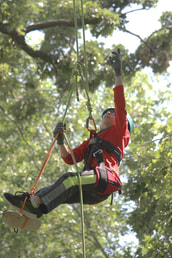 Camden picks out his goal for the climb Camden picks out his goal for the climb Sometimes changes to our situation are outside of our control. While this can be frustrating and at times intimidating, we still need to work through the challenges we are faced with. In doing so we are also working on our personal growth and development. In both cases, change presents a number of challenges you will need to address if you have the determination to continue in pursuit of your goals. Change, challenge, and growth go hand in hand. Sooner or Later When you come up against a challenging situation, how often do you find yourself giving up in hope of there being an easier path rather than working through the difficulty? There have been plenty of challenges I have faced over the years. Some I tackled, others I turned away from. As you’d expect, some of the ones I took on resulted in failure. It seems most of the challenges I chose to avoid ended up coming back across my path at a later point. In either case there were plenty more challenges ahead. With this understanding, I find myself more inclined to approach challenges head-on. Even if I fail today, I can walk away with two things in mind: knowing I did not give up and gaining insight on where I need to improve. Some Challenges Are Too Difficult...At This Point Giving up when encountering adversity may be seen as self-preservation in some instances, but in many cases it has a detrimental effect. Giving up too soon means you are giving up on yourself, which can lead to lower self-esteem. If you take on a challenge and fail, you have a better chance at walking away with insight on why the challenge was too much to overcome at this point in time. With that knowledge, you are better equipped to formulate a plan to strengthen yourself. By working on improving yourself, you will have a better chance at overcoming that challenge in the future. If your goal is worth it, you will face the challenge again. When a problem is too much for me to handle, I look for ways to break the larger problem into stages. Smaller challenges can be easier to tackle. As I progress through the smaller challenges and stages, I am not only building my skills, but also experiencing an increase in my sense of self-worth. This positive reinforcement of my abilities compounds as I progress through each of the stages, ultimately achieving success in overcoming what had previously been a challenge I couldn't handle. Successes like this provide me with a tremendous boost in self-confidence. 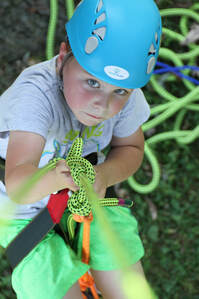 Sullivan is focussed on his goal of reaching the first branch Sullivan is focussed on his goal of reaching the first branch Our climbers experience this firsthand. When they show up without ever having climbed with rope and saddle, we start them off with a basic understanding of the technique necessary to climb. It is their determination and physical ability that will be required to reach their ultimate goal. Your goal may be to reach the top of your rope. Seeing the goal and wanting to be there is not enough to get you there. You will have to work for it and it will be challenging. However, if you remain focussed on taking small steps upward, you will eventually reach that goal. For those people who lose focus on or try to skip the steps required to take them higher, it is highly unlikely they will reach the top before they are exhausted and frustrated. While the encouragement we provide is powerful, our most effective form of assistance is to bring their focus back to tackling the small challenges. When smaller, more manageable challenges are accomplished back to back, you are able to achieve your ultimate goal for the day. Change Is Inevitable...Thankfully When I do not have others around to help encourage and motivate me as I work through a challenging time, I have to rely on myself. This is best done when I face the challenge rather than avoiding it. If it is too great for me today, then I will take it one day and one step at a time. In doing so, not only will I be more likely to succeed, but also better capable of achieving more difficult challenges that lay ahead. Whatever changes and challenges await me tomorrow, I welcome them because I take comfort in knowing that they will keep me growing. The growing season has begun - keep an eye out for emerging leaves and flowers in the coming weeks!3/26/2020 One of the details I appreciate in spring are the newly emerging leaves after they have just pushed out of the buds. These miniature leaves will continue to expand and grow in size through the weeks ahead, capturing the vital sunlight to make the food the tree needs for healthy development.
Name: Captain Tony Species: bur oak Height: 55 ft Trunk Diameter: 3ft 2in Spread of Branches (tip-to-tip): 55 ft Approximate Age: 100-150 yrs It seems every time I visit this tree I am treated to a wonderful encounter. Approaching this tree in the morning provides the opportunity to watch the foggy mist rolling across the lake. The soft wisps have a calming effect on my mood. I often take pause during my morning climb preparation to appreciate the beauty and song of a pair of loons on the water. As the sun begins to rise, I am energized by the rays of light shining through the mist and their wonderful reflections in the branches above.
One particular summer day, I climbed into this wonderful oak to take time for myself. I went up there to enjoy the view across the water and lay back on a branch shaded from the leaves above. Being a rather warm and humid day, a song came into mind; “I went down to Captain Tony’s to get out of the heat.” You may recognize the lyric from a Jimmy Buffett song where he sings of the man and saloon in Key West. For a brief moment, I was back in the Keys heading in for a break from the sun and heat. It was at that moment this tree became known to me as, Captain Tony. Trees are living beings and I am often moved to formally recognize certain individuals by name. The name is not so much a tribute to a person or place; but, to the emotion, feelings and reflections I experience when in the presence of this tree. 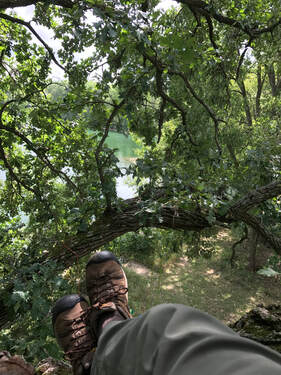 With over 50 species of oak in North America, bur oaks are known for their impressive branch spread and trunk diameter. Living in Wisconsin provides us the opportunity to appreciate large bur oaks on a regular basis. The largest bur oaks have branches reaching 100 feet across and trunks close to 9 feet wide! Wisconsin’s largest known bur oak has a trunk over 7 feet in diameter and is located in Waukesha County. Walking around Fox Brook Park you are able to appreciate a number of large and majestic bur oaks. Each has their own presence about them and worthy of taking time out of my day to stop and appreciate. Captain Tony is a little more modest in size yet extra special as I have spent time in his branches. Those of you who have climbed Captain Tony may know what I am talking about as you have your own memories and connection to the tree. This tree touches people in different ways, so I am excited to offer a variety of experiences this year. Should you like us to introduce you, we will visit the tree on numerous occasions in the year ahead: Adult Tree-Time, Rec Climbs, Open Climbs, Girl Scout Adventure Climbs. Our climbing club will also have the opportunity to explore the canopy and enjoy hammocking! 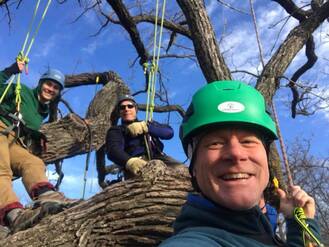 You don’t need to dig into research studies to know that teams that work well together tend to achieve great results. You can probably spot a high-performing team without much thought. Think about how everything comes together for your favorite sports team during a successful scoring drive. While ‘Hamilton’ might be a great musical, your enjoyment of the live performance is dependent upon the actors, musicians, sound and lighting crews being in-sync the night of your performance. In either case there are a number of team members involved. No matter how large the group is, it can produce good results when each member is focused and successfully completes their own task. Amazing results, however, can be achieved when members work together by performing their respective role while being supportive and encouraging of fellow teammates. This idea is at the heart of why team-builders and bonding events are used to improve a team’s overall performance. Aim Higher Companies and organizations spend a lot of time, money and energy looking for ways to improve morale and develop their employees and teams to help them achieve amazing results. Team-building exercises and social events are two ways they try to accomplish this. While there is plenty of research showing the value and benefits of these types of activities, in reality they are held in low regard by the majority of employees. Think of your own feelings when you hear you’ll be participating in a team-building exercise. When you’ve been in the position of planning such an event for your employees, colleagues, or group, did you sense a challenge of getting them motivated to participate? On one hand, you understand that team building exercises can be used to energize the group and improve morale and productivity. On the other hand, maybe your efforts have failed to achieve these goals, or worse, lead to anxiety and resentment. Unfortunately, many of the typical team-builders are structured or executed in a way that simply replicate the same patterns and struggles that already occur within the group. Give Them Something To Talk About To be successful today, you need to consider new ways to achieve the results you are looking for. There isn’t a single solution, but there are alternative methods to motivate and improve your team’s performance. Out of the ordinary experiences are a great way to break through some of the negative impressions people may have. Some of the more successful exercises I have come across have two things in common: they provide a “wow” factor and were not expressly designed as a traditional team-builder. Being somewhat obscure to the general public, recreational tree climbing is an activity that provides a “wow” factor for most people. Regardless of a person’s initial response being either one of excitement or one of apprehension, their curiosity is certainly piqued. Most fears and apprehension can be addressed through communication prior to activities like tree climbing. At the same time, it would be a mistake to assume that requiring each person to climb is necessary to achieve results. Spectators enjoy the activity and participate in the overall experience without ever leaving the ground. Watching people climb is exciting in itself. That boost in energy feeds the underlying desire to see people reach their goals and expresses itself through spectators and their use of words of encouragement towards participants. In addition, a climber’s ability to participate and reach their goal is not dependent upon the other climbers. This may sound contrary to the goal of traditional team building exercises that demonstrate how a team cannot achieve its goal without each person fulfilling an individual task. There are plenty of exercises out there to get that point across, including the daily work experience. As an alternative experience, the end result will demonstrate that while one may be focused on their individual task, their success is profoundly impacted by the support and encouragement they receive from others. In addition, they feel empowered to provide the same to the other participants. Our regular climbing events allow individuals to come to us to climb. These participants typically do not know the other climbers in the group. What consistently occurs with each group of participants is that they begin to relate to each other. In a short amount of time, complete strangers are in conversation together. Everyone is outside of their comfort zone dealing with their own challenges, which helps them relate to each other. This tends to manifest as a desire to help others achieve their goals. Teams that achieve amazing results are those that have members who are not only capable of performing their required task, but arguably more important, able to be supportive and encouraging of the others. Experiences like recreational tree climbing fosters this type of interaction amongst participants organically. Shoot for the Treetops I agree with Andre Lavoie, “creating bonding experiences employees actually like fosters a workplace culture of friendship, which directly improves morale and productivity.” These bonding experiences can come from a variety of unique and innovative activities. Recreational tree climbing is one option, but I am sure you can think of others that might achieve your objectives and goals. It can be challenging to avoid falling into the trap of pulling something out-of-the box that is easy to set up. Before you take the easy road, ask yourself how it will be received by your team and will it ultimately provide the result you desire? Need help aiming higher? Look into some unusual team-builders here. Of the groups who come to us for the recreational tree climbing experience, some will schedule an event as a stand-alone activity for a particular team or group. Others choose to offer it in conjunction with a company picnic or event. This can spice up a routine gathering while helping to avoid the anxiety some members might feel if it sounds too extreme for them. Even if you are the one who is apprehensive with such an activity and prefer to remain firmly on the ground, you may find yourself inspired to try it out after you see and understand the safety and control each climber has. Regardless of whether climbers have come to us for the therapeutic and developmental benefits or for recreational pleasure, each climber experiences a feeling of connection to the other individuals in the group they are climbing with. How do you think your group will feel and interact the next time they convene after sharing an experience like this? Start planning a tree-climbing experience for your group here. Some people take on exciting and risky endeavors such as wingsuit flying, base jumping, and free-climbing rock faces. You might have even tried a few yourself. Maybe bungee jumping or skydiving? Extreme sports tend to involve activities that take on higher associated risks, thereby increasing the level of danger for the participant. Often times the risks are increased through elevated levels of speed, height or mental and physical exertion. Participating in these types of activities produces a rush of the epinephrine in the body, the hormone associated with the “adrenaline rush.” The “adrenaline rush” is experienced as a reward by some people and thus creates a drive to participate in extreme activities. What might be extreme to you may differ greatly from the next person, therefore we each experience adrenaline rushes at different levels of participation in the same activity. You can experience the rush simply by stepping outside your comfort zone. One Step Over the Line On occasion I am able to get out with a friend to climb rock. Since all of our climbing is done on rope, we hike to the top of our chosen rock face in order to set up the top-rope system. Once he has all the gear in place, we take the shortest route down…stepping off the edge of the cliff. Stepping off the side of a cliff is not part of my daily routine; therefore, I find it quite exciting. It tests my nerve every time! Once over the edge and hanging on rope, rappelling 50 feet down the side of the cliff is relaxing comparatively. Then there are people like Alex Honnold, who free-climbed El Cap. No harness, no rope. To put it into perspective, the wall routes at Adventure Rock reach just over 40 feet and our highest ropes in our climbing trees tend to be between 40-55 feet high. The El Cap route Alex climbed was 3,000 feet. Chills ran down my spine as I watched his journey in the 2018 documentary, Free Solo. I feel an adrenaline rush just thinking about it! As I stand at the base of a cliff or wall and look up, I recheck my safety system. Did we inspect all of the equipment? Is the fall protection system installed properly? Do I trust my belayer? Until my confidence level increases during an ascent, I feel adrenaline release in my blood stream. It is invigorating. Even if we might have grand visions of accomplishing feats like Honnold or simply jumping out of a plane to try skydiving, we know we lack the ability and usually the equipment to do so. Or maybe we’re just a bit more cautious. Do Something Out Of The Ordinary Ziplining and High-ropes courses tend to elicit an invigorating adrenaline rush in many people. We are faced with the fear of falling. If you already have a fear of heights, the effect can be more intense. While tree climbing may fall in the same arena of adventure activities like these, it tends to elicit different responses. Since climbers are in control during their time above the ground, you tend to experience less of an adrenaline rush, yet still feel energized and invigorated. This feeling is likely caused by the release of hormones such as dopamine, serotonin and endorphins. These are some of the “happy hormones” as they provide a boost of feel good energy, without the stress-related impact of the adrenaline rush. For most people, just getting ourselves off the ground is stepping outside of our comfort zone. This where the thrill of the climb begins. Those energizing hormones begin to release. I find it particularly enjoyable when these hormones are at greater levels than adrenaline. As you climb higher, you will eventually encounter the height that registers for yourself as one where you are no longer near the ground. Meaning, you are acutely aware you have stepped outside your comfort zone. For many people this height is reached about 10-15 feet, and maybe 30 feet for others. With tree climbing, you are in control of your next decision. Once you reach that first ceiling, what is your next move? Climb higher, hang out and enjoy the comfort of hanging in your saddle, head down? Once acclimated to the distance above ground, most people opt to climb higher. Decide to climb higher, you’ll feel another flush of those energizing hormones. This process repeats during your climb. When you reach the lowest branches of the tree’s crown. Getting onto or off of a branch, questioning whether you will still be held aloft during each transition. When you reach the top of your rope. Each time receiving a flush of energy. What Level of Extreme Are You Looking For?
Recreational tree climbers live around the world and come from all walks of life. Many head out in search of the tallest trees in order to reach heights of 200-350’. Some are looking for trees and vistas in remote locations, taking them into jungles and rainforests shared by pit vipers, stinging insects and other critters that can cause harm when encountered. Climbing arborists work in the trees daily. Their work requires precision skill to situate themselves into a proper working position to avoid straining muscles or being hit by the piece of wood being removed. Their work might involve operating a chainsaw with the chain rotating near 60mph as 1,400 cutting teeth pass by a specific point per second. Can you picture yourself in either of those situations? Do they seem a little more extreme than climbing the tree in your backyard? Maybe you have tried or have seen a tree climber limb-walking, where they walk out towards the end of a branch. In doing so, they are no longer hanging directly under their suspension point; therefore, now relying more and more on their ability to balance their weight on the branch. The awareness is very much present that if they slip, they will fall & possibly swing uncontrolled towards the trunk. I mention all of this to put into perspective that many tree climbers experience and are often driven by situations that provide an adrenaline rush during the climb. The work is demanding, very rewarding, and ultimately provides the thrill that some of us spend our money on for recreation. Do you think of yourself as someone who is not ready to throw caution to the wind and truly willing to risk severe injury or death? It is fortunate, then, that you can search out experiences under more controlled circumstances where those consequences are not at stake, and push the limits of your comfort zone at your own pace. All new climbers learn to ascend the rope using beginner techniques, which we teach at all of our events. With time, some people advance to faster and more efficient techniques that Curt demonstrates in this video. It’s the technique of climbing rope that gets you high up into a tree, no matter your level.
By Kevin Andrews What matters most to you as the parent of a child between the ages of 5 and 10? Research shows four items consistently rank among the top:
Would you believe there is a path to achieving all four of these? Physical activity plays an important role in developing the brain and supporting essential mental functions. As an elementary teacher for the past 20 years I have witnessed the benefits that regular physical activity has provided to the vast majority of my students. Physical activity helps develop students in a range of ways. Not only does it help their physical health, it also helps improve brain function and your child’s emotional wellbeing. Research shows that regular to moderate intensity exercise can increase the size of the hippocampus, an area of the brain involved with learning and memory. Exercise also helps release growth factors, chemicals in the brain that affect the growth and survival of new brain cells as well as blood vessels in the area. Exercise leads to improved motor skills, better analytical and problem-solving skills, stronger attention skills and overall improved learning. So how do we accomplish this in our schools now-a-days? Engaging and Experiential Most people would answer with the obvious PE and Recess. Educators of today are looking for new, engaging, and creative ways to meet those needs without the use of technology-based methods. One method my school has explored over the past few years is through tree climbing. Companies such as Treetop Explorer are helping educators connect physical activity with a variety of learning opportunities. When children are physically engaged and “living” an experience, their retention rates show a dramatic increase. Whether it be studying the biology of trees, using the peacefulness experienced in a vertical change of scenery for journaling or writing poetry, or studying the force of gravity on different objects, the connections between academics and physical activity are endless. The best part………KIDS LOVE IT! The #1 Field Trip!
In the four years since our school began implementing a tree climbing program with our third graders, the excitement from students and parents has grown exponentially. It is the #1 “field trip” 2nd graders are excited to experience in 3rd grade, and one of the top 3 memories our 5th graders have of their entire elementary experience. Each climbing event is held during the school day, yet each year we have a growing number of parents taking time off of work to come watch their children soar into the trees. Not only has this experience become more and more popular with the parents in my school, but it’s now being implemented in all four of the elementary schools across our district. The experience has been met with much enthusiasm from parents, students, and teachers alike. But beyond the enjoyment factor lies the connection between the academics, physical activity, mental health, and social experience that the tree climbing experience provides to each and every one of our students. The tree climbing experience helps us provide students with an alternative learning experience that gets them out of their chairs and into the trees. Kevin Andrews is an elementary teacher in St. Louis, Missouri. He has been teaching since 2000 and has worked with kids between the ages of 5 and 10 as a Classroom Teacher, Content Specialist and Instructional Coach. He introduced the tree climbing experience to his 3rd grade team in 2015, and it has since grown to being implemented across the four elementary schools in his district, reaching more than 400 new students on a yearly basis. Statistics Name: Georgia Oak-eeffe Height: 85’ Trunk Diameter: 34” Spread of Branches: 65’ Approximate Age: 50-70 years About the Tree At one time, the world’s largest known pin oak was right here in Wisconsin. It was growing on the campus of UW Stevens Point since 1894, but was removed in 2017 after being infected with the lethal oak wilt disease. During its 123 years of life, it had reached 92 feet in height with the trunk being over 4 feet wide. Pin oak is somewhat unique in its tendency to exhibit a strong central trunk rather than the sprawling nature of other oaks. This form, paired with a relatively fast growth rate, leads them to attain impressive heights within their short lifespans compared to other oaks. Our climbing tree in Sun Prairie is the only pin oak in our current line-up of climbing trees. This tree is surrounded by a handful of other impressive pin oaks and I encourage you to come out and meet them during one of our climbs. 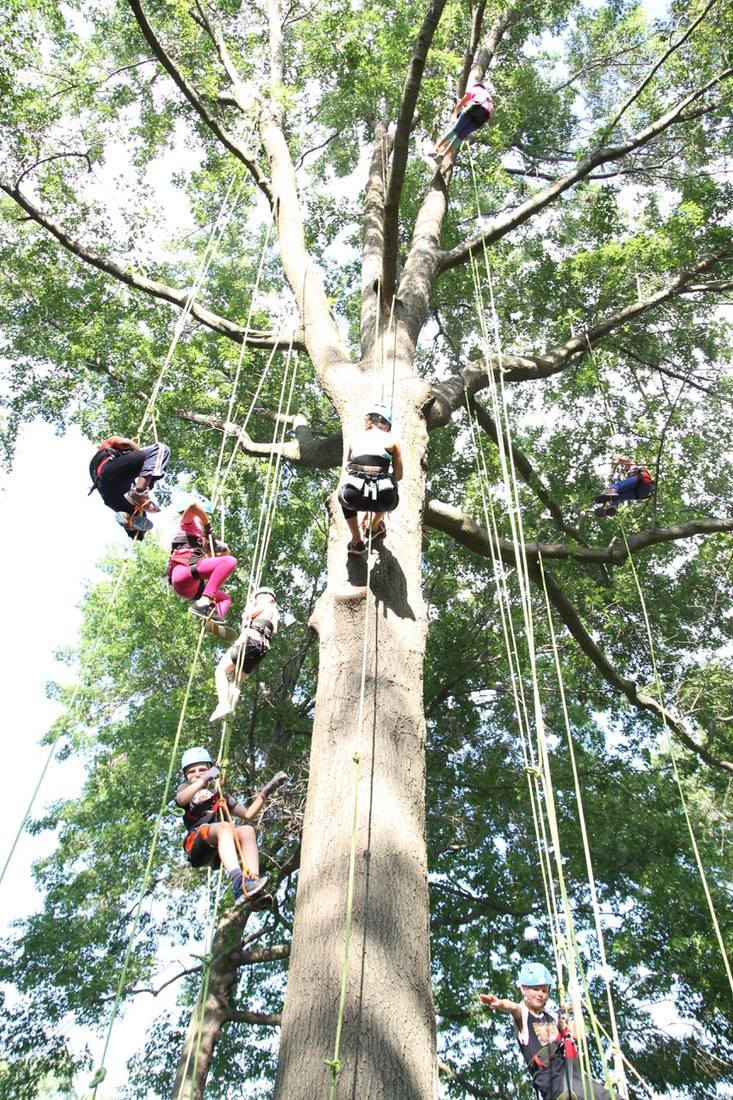 The scientific name (Quercus palustris) comes from the Latin word for marsh, palus, indicative of the habitat where it is typically found in nature. The species tends to grow in lowland areas of the Midwest states, however, it can be grown across the continental U.S.
Having the ability to tolerate pollution and compacted soils, pin oak has been one of the most widely planted oaks in urban landscapes. Before you decide to plant this tree however, beware that the tree can face nutritional issues when growing in clay soils. Starting my career in Missouri, I was fortunate to work with pin oaks that reached 100 feet in height. Since the species tends to hold on to its dead branches and twigs, I spent a lot of time in these magnificent trees. |
AuthorAs a G.O.T.C. Recognized Master Instructor & Facilitator, I.S.A. Board Certified Master Arborist, and T.C.I.A. Certified Treecare Safety Professional, Curt has spent over 30 years dedicated to the study and care of trees. Categories
All
Archives
April 2024
|
|
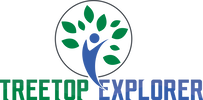



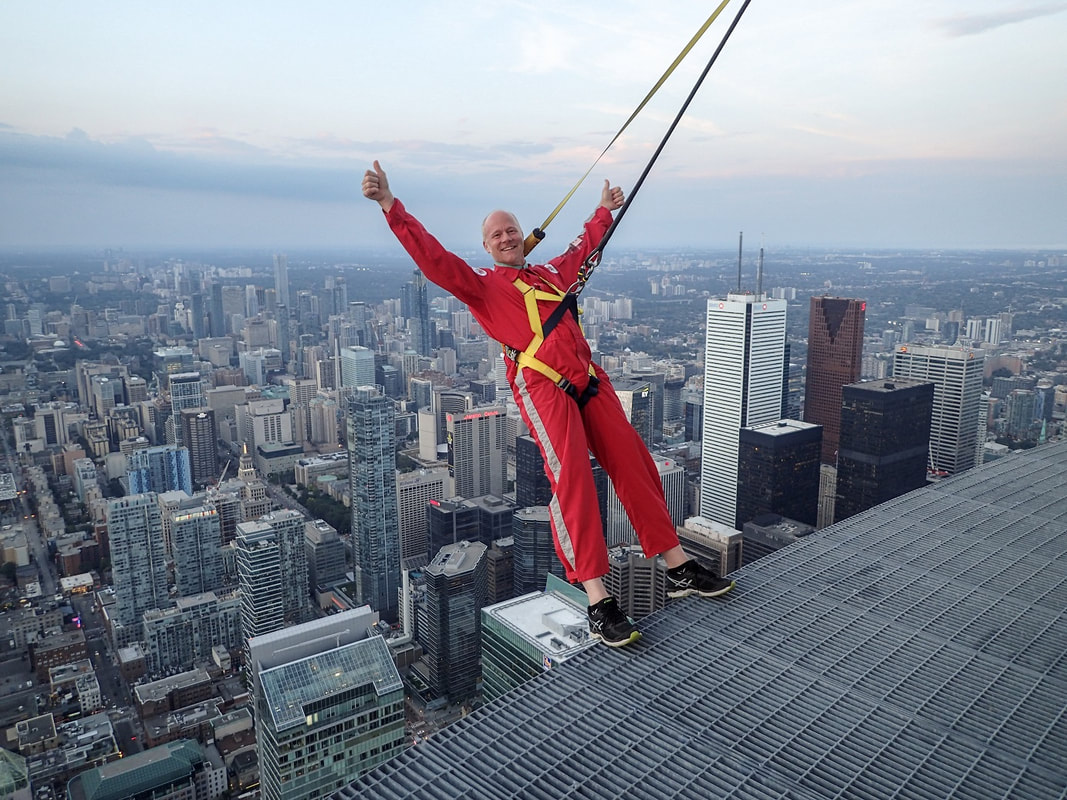
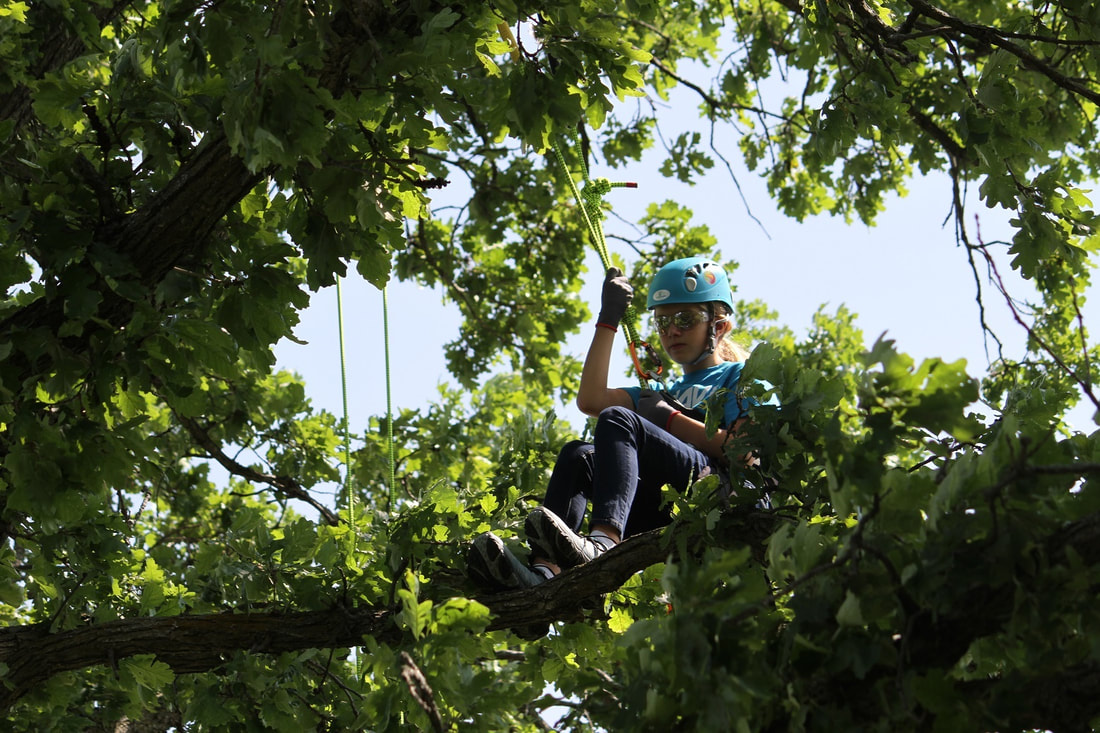
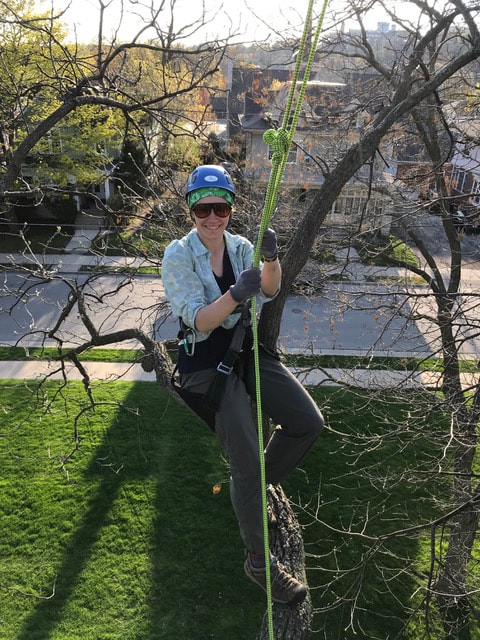




 RSS Feed
RSS Feed
